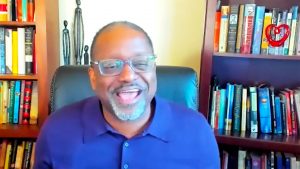By Daniel Dunaief
Cold Spring Harbor Laboratory’s DNA Learning Center and the Red Cloud Indian School recently launched a program called Students Talk Science in which high school students could ask questions from several senior scientists about the vaccine for COVID-19 and healthcare disparities in minority communities.

The talks are a component of a program called STARS, for Science, Technology & Research Scholars, an effort the group started in 2019 to build interest and experience in STEM for minority students. The Students Talk Science program engaged the STARS participants and students from the Red Cloud Indian School on the Pine Ridge Indian Reservation.
Jason Williams, Assistant Director of Inclusion and Research Readiness at the DNA Learning at CSHL; Brittany Johnson, an educator at the DNA Learning Center; Katie Montez, a teacher at the Red Cloud Indian School ;and Carol Carter, Professor in the Department of Microbiology and Immunology at the Renaissance School of Medicine at Stony Brook University, wanted to connect minority students with practicing physicians and scientists in leadership positions at the National Institutes of Health to allow them to ask questions of concern regarding the vaccines.

“We did this to empower them to function as trusted resources for their families, friends and network,” Carter, who participated as an individual rather than as a formal representative of Stony Brook University, explained in an email.
The conversations included interactions with Dr. Eliseo Pérez-Stable, Director of the National Institute on Minority Health and Health Disparities, or NIMHD at the National Institutes of Health; Dr. Monica Webb Hooper, Deputy Director of the NIMHD; Dr. Gary Gibbons, Director of the National Heat, Lung and Blood Institute; and Dr. Eugenia South, Assistant Professor in Emergency Medicine at the Hospital of the University of Pennsylvania and the Presbyterian Medical Center of Philadelphia.
The high school students prepared informed questions.

“The students were encouraged to do their own research” on the interview subjects, Williams explained. “We asked students not to look just at [each] interviewee’s science work, but also any personal background/ biography they could find. Students had multiple opportunities for follow up and were largely independent on their choices of questions.”
Samantha Gonzalez, a student at Walter G. O’Connell Copiague High School, asked South about her initial skepticism for the vaccine.
South acknowledged that she had no interest in taking the vaccine when she first learned she was eligible. “I almost surprised myself with the fierceness with which I said, ‘No,’” South said. “I had to step back and say, ‘Why did I have this reaction?’”
Some of the reasons had to do with mistrust, which includes her own experiences and the experiences of her patients, whom she said have had to confront racism in health care. In addition, she was unsure of the speed at which the vaccine was developed. She had never heard of the mRNA technology that made the vaccines from Moderna and Pfizer/ BioNTech possible.
“I had to do my own research to understand that this wasn’t a new technology,” she said.

South went through a learning process, in which she read information and talked to experts. After she received answers to her questions and with the urging of her mother, she decided to get the vaccine.
“I’m so thankful that I was able to do that,” South said.
The team behind Students Talk Science not only wanted to empower students to make informed decisions, but also wanted to give them the opportunity to interact with scientists who might serve as personal and professional role models, providing a pathway of information and access that developed amid an extraordinary period.
“We wanted to engage high school students in something unique going on in their lifetime,” Carter said.
To be sure, Carter and Williams said the scientific interactions weren’t designed to convince students to take the vaccine or to urge their parents or families to get a shot. Rather, they wanted to provide an opportunity for students to ask questions and gather information.
“We purposely did not participate in the discussions because our goal was not to convince or ‘preach,’ but to enable students and their networks to make informed decisions,” Carter said.
Parents had to read and sign off on the process for students to participate. The organizers didn’t want a situation where they were doing something that conflicts with a parents’ decisions or views.
Williams added that the purpose of the conversations was never to say, “you must get the vaccine. Our purpose is to talk about information.”
The objective of these interactions is to help minority students find a track for a productive career in ten years.
In addition to questions about hesitancy, Williams said some of the high school students expressed concerns about access to vaccines. He is pleased with the result of this effort to connect students with scientists and doctors.
The group was “able to get some of the most important scientists in the country to sit with high school students,” he said. “It was very powerful to give students access to these role models.”
The goal is to stay with these students, mentor them and stay in touch with them until they graduate from college and, perhaps, return as research scientists.
Even for students who do not return, this type of interaction could provide an “impactful experience that prepares them for other opportunities,” Williams explained, adding that the STARS program would incorporate the Students Talk Science Series into the program more formally in the future, with new students and topics most likely during the school year.
The interviews are available at the following website: https://dnalc.cshl.edu/resources/students-talk-science/.





